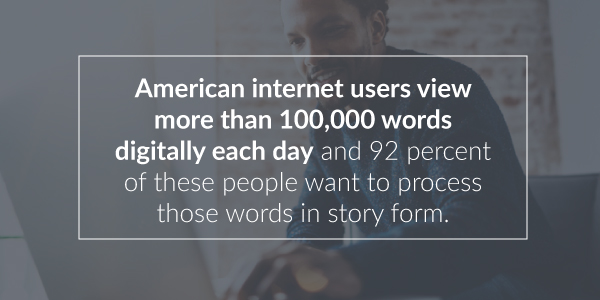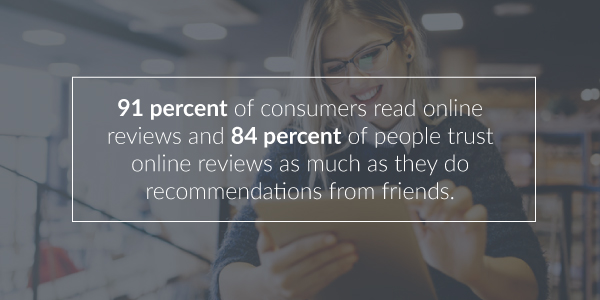Data is becoming an increasingly important part of marketing. Today, we gather more information about our companies’ performance, our customers and our industry than ever before. This knowledge helps brands improve their products, customer service and marketing.
Technology and data are just part of the equation, though. Brands have to be careful not to neglect their human side in favor of robot-like interactions. Marketers need to connect with people to form business-customer relationships — and nobody connects with people better than other people. Bots just aren’t good at that. At least, not yet.
That doesn’t mean you should ignore data, though. Organizing and analyzing the information you collect can help you form relationships with customers if you use it to get to know them better. There’s a link between brands, consumers and data — and accessing that connection can provide benefits both for your company and for your customers.
How to Use Data
Lots of companies collect data. But that’s just the first step. All of those facts and figures won’t do you any good if you can’t figure out what they mean. Collection is crucial, but so is organizing your data, analyzing it and putting it to use. The team at Lotame can help with all those parts of the process.
This information can help you improve your targeted advertising, your content and your customer experience, whether you’re a marketer trying to reach customers directly or an agency who wants to improve campaign performance for your advertisers.
One of the best ways to accomplish these goals is understanding how people connect with your brand. By learning about what specific consumers or groups of consumers are interested in, you can show them products or ads they’ll like. Feedback about why consumers like your brand can help you connect with them if you double-down on those aspects or make them a more central part of your promotional campaigns.
You can also use behavioral data, which shows you how people have interacted with you, to understand your relationships with customers better. For example, you might find that people most often visit your website on mobile devices and, consequently, target more of your ads to mobile. You can also find which of your products, downloads and blog posts are the most popular.
Consumers Gravitate Toward Compelling Stories
One of the most valuable strategies for creating a connection is telling a compelling a story. A list of facts only engages the language portion of the brain when it’s figuring out meaning. A well-told story, on the other hand, causes us to use many other parts as well. This enables us to feel like we’re really there, experiencing the thing we’re reading about. This makes it easier for people to remember what they view and connect emotionally with it.

After all, we love a good narrative. American internet users view more than 100,000 words digitally each day and 92 percent of these people want to process those words in story form.
Our brains are also always looking for stories. We spend about a third of our waking hours daydreaming. In a typical hour, we tell ourselves about 100 stories in our heads. When we’re reading or watching an engaging story, we typically don’t daydream at all. One of the most reliable ways to get our brains to stop daydreaming is to engage with a story on the outside. In short, we crave stories. Brands can take advantage of this to capture the attention of their audience.
Stories can also engage a reader’s emotions, which is a crucial part of forming a human relationship. A relationship that involves emotion and honesty can lead to trust — the number-one thing that people want in their communications with companies.
To obtain all the benefits of storytelling, you need to tell your story well and in a way that connects with customers. It has to pique people’s interest and retain it — and then your message has to stick in their head. Here are some tips to help you do that:
- Include a catchy title: The title of a post is typically the first thing a reader sees. And if it doesn’t catch their attention, it might also be the last thing. Make your title intriguing and make sure it entices them to read the rest of what you have to offer. Just don’t be coy to the point of frustrating the reader.
- Keep it short: People have a limited attention span, especially since they have so many options when it comes to content. Keeping your content short and easily scannable is an important tactic for connecting with customers digitally. It’ll help you retain more readers or viewers until the end of your article or video.
- Have a clear storyline: For marketing purposes, you don’t need a complex plotline filled with twists and turns. Simple narratives that move in a direction and at a pace that are easy to understand work best. Your main goal should be to convey your message as clearly as possible in a way that resonates with your audience.

- Use visuals: The brain processes imagery 60 times more quickly than it does words. Using visuals can help capture people’s attention and keep them engaged, since they’ll be able to process the information faster. You don’t have to include pictures in everything, but it’s always an excellent element to add.
- Be consistent: Keep your story straight. Convey the same message across all platforms and devices. If customers keep two different ideas of who you are as a company on different social media sites, they won’t feel like they know who you are and might even lose trust in your organization, hampering your efforts to form relationships significantly.
The Importance of Mutual Affinity
As you know, a relationship is not a one-way street. Forming a true connection requires input from both parties. This holds true for relationships between brands and customers. Creating a positive and productive customer-brand relationship requires mutual affinity. Your customers need to care about you and you also need to show you care about your customers.
Of course, companies do care about their customers — or at least they should. Customers are what drive their revenue and keep them in business. To make that all-important connection, you need to demonstrate this to customers and, ideally, go beyond that, too.
Customers might understand this concept, but they want you to show them that they’re a priority. Every business needs customers, but you want your customers to feel that you care about them more than the average company. That way, they’ll choose you. In a survey of 1,000 consumers, 65 percent of respondents said that feeling like a brand cares about them helps create an emotional connection with that brand, making it the top response.

Demonstrate your loyalty to your customers by getting to know them, being responsive and doing your best to meet their needs, and they’ll return that faithfulness. Customers who feel like they matter to you are more likely to become repeat customers and even brand evangelists: people who promote your company by recommending you to friends on social media as well as face-to-face.
The third-most-popular answer in that survey for what inspires an emotional connection with a brand was feeling “like they get me.” It’s not enough to just show that your customers are important to you. You have to give them something they like and that makes them feel as though they belong in your brand’s tribe. And to do so, you need to really get to know your audience.
The data we collect allows us to more easily learn more about our customers than we ever could before. Companies can gather information about their target audience’s demographics, such as their age, gender, location and occupation. They can also learn about their interests, values, likes and dislikes and what they look for in the brands they buy from. Companies can then tailor their messaging to play to the attributes their customers have or value.
Of course, you can’t just find out what your customers like and then pay it empty lip service. Trust is the foundation of customer relationships — along with honesty and transparency. Breaking that trust can lead to backlash. Customers who like you may support you online by posting positive things about you on social media and writing glowing reviews. Those who have a bad experience may call you out online.
If you find out there’s something that your audience wants that you don’t have, you could work on ways to incorporate that into your brand and your operations. Then, when you advertise that to people, you’ll likely gain some new followers. For instance, if you discover that much of your target audience values sustainability, you could work to become certified by environmental organizations and then incorporate those accreditations into your advertisements.
You might also want to mine data on what the customers you already have like about your brand. Once you find out your strong points, you can place more focus on them in the marketing materials you use to connect with new groups of potential customers.
How to Create Connections for Your Brand
We already know that creating connections with your audience is crucial for gaining new customers and keeping the ones you have. We’re also aware that creating trust — getting to know your customers, telling engaging stories and using data — can help you do that. Here, though, are some specific strategies for creating those vital connections with your audience:
1. Share Consumer Success Stories
People trust the experiences of other customers. Evidently, 91 percent of consumers read online reviews and 84 percent of people trust online reviews as much as they do recommendations from friends. That’s why sharing stories of people’s positive experiences with your brand can be so helpful. They create trust in your brand, add a human element to it and can even initiate the formation of a community of loyal fans of your brand.

To get more of these success stories, make it easy for people to share them. Add a page where people can submit testimonials or reviews on your website. You can then promote the most compelling ones. Also, collect reviews from popular review sites like Yelp and Google Reviews. Thank customers for positive reviews and include them in your marketing materials. If you come across a negative review, respond publicly with an apology and an offer to fix the situation.
2. Write Your Origin Story
Every brand comes from somewhere and every brand should have a well-defined “personality” that makes them unique. Sharing the story of how your company came to be will help people connect with you — it makes your brand more relatable by adding some humanity to it.
You should also include the ongoing story of how you are now. What are your company values? What sets you apart? Who are you as a brand? Create a brand that people can connect with. Remember to incorporate data on your audience’s values when crafting this image and to be consistent.
3. Use Data to Personalize
You can use the information you gather about your customers to present them with personalized messaging. This will help them form a more personal relationship with your brand and show them that you really “get” them. It can also lead to increased sales, which is why personalization is such as huge up-and-coming trend in the marketing and data industries. One study found that emails that included personalized aspects had transaction rates that were six times higher than generic emails.

So? Call customers by their name. Tailor your offers to where they live, their age group and their interests. For example, you could send them a coupon to a local store rather than a generic one. You might also show them products similar to ones they looked at before or reminded them of products they viewed but didn’t yet make a purchase decision on.
4. Remember to Customize for Your Audience
Not all audiences respond the same way. Plus, their actions and interests will likely change over time. That’s why it’s crucial to continuously gather, organize and analyze customer data. The more time you spend learning about your customers, the more you’ll be able to preemptively meet their needs.
There definitely isn’t a one-size-fits-all strategy. Luckily, enhanced customization capability is one of the biggest benefits of data. You’ll need to tailor your marketing based on your industry, your company and your customers and may even have to interact with the various segments of your audience differently. As mentioned earlier, you can even customize for each individual customer if you really drill down.
Data Management Solutions
To use data to make decisions and help you form customer connections, you need to a way to collect, onboard, store, organize, enrich, analyze, and activate it — and that’s exactly what a Data Collaboration Platform, or DCP, is designed to do.
Lotame offers an all-in-one solution for digital marketers, agencies or media owners, empowering digital marketers to unite, analyze, and activate data for innovation and growth. With Spherical, digital marketers can combine data internally and partner externally for actionable customer intelligence, data informed audiences, and identity powered activation.
To learn more about our solutions and what we offer explore our online resources or browse our product page. You can also contact us and request a demo here.


